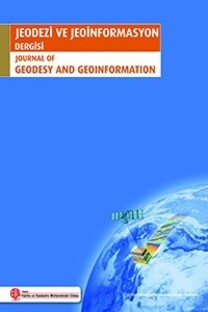Koordinat dönüşümünde EIV model klasik dengeleme yoluyla nasıl çözülür?
Bir koordinat dönüşümü probleminde yalnız bir sistemin değil, her iki sistemin koordinatları rasgele hatalı olabilir. Böylesi bir durumda ilgili problem, EIV model çerçevesinde ele alınır ve WTLS yöntemiyle çözülür. WTLS yönteminin uygulanmasında iki temel zorlukla karşılaşılır: 1 Çözüm için, EIV modelin katsayılar matrisinde geçen tüm elemanlara ilişkin de uygun bir kofaktör matris düşünülmelidir. Dönüşüm probleminin türüne bağlı olarak, katsayılar matrisindeki bazı elemanlar, iki ya da daha fazla kez aynı ya da farklı işaretli olarak geçtiği ve bazı elemanlar da hatasız olabildiği için, bu, her zaman kolay bir işlem değildir. Bu nedenle, modelin stokastik kısmını oluşturmak özel bir çabayı gerektirir. 2 WTLS çözümüne ilişkin eşitliklerin elde edilmesi, bilinen en küçük kareler dengelemesine göre oldukça karmaşıktır. Bu da, bazı nümerik ve istatistiki yöntem ve fikirlerin çözüme uyarlanmasını zorlaştırır. Söz konusu zorlukları ortadan kaldırmaya yönelik olarak, bu çalışmada, ilgili problemin çözümünün alışılageldik dengeleme yoluyla nasıl yapılacağı irdelenmektedir. Bu amaçla oluşturulan bir dengeleme işleminin WTLS çözümüne denk olduğu, matematiksel olarak gösterilmektedir. Söz konusu dengeleme işleminin çıkarımı, burada 2B Afin dönüşümü için çalışılmıştır, ancak, herhangi bir koordinat dönüşümüne kolayca uyarlanabilecek biçimde anlatılmıştır
Anahtar Kelimeler:
EIV model, WTLS çözümü, İteratif dengeleme, 2B Afin dönüşümü
How to solve errors-in-variables model for coordinate transformations in a classical adjustment way?
In a coordinate transformation problem, the coordinates of both systems may have random errors. In such a case, the corresponding problem is considered within the Errors-In-Variables EIV model and solved by the method of Weighted Total Least-Squares WTLS . However there are two main difficulties while applying the WTLS method: 1 A proper cofactor matrix for all elements in the design matrix of the EIV model is also to be formed. This is sometimes confusing work because some elements may be repeated twice or more in the same or different signs and some elements may be error-free coefficients in the design matrix depending on the type of the transformation problem. Hence setting the stochastic part of the model needs a special effort. 2 The derivation of the equations of the WTLS solution is complicated in contrast to the least-squares adjustment. So it may not be easy work to adapt some numerical and statistical methods and ideas to the solution. In order to remove these difficulties this study discusses the solution of the corresponding problem in a classical adjustment way. It is shown mathematically that the adjustment procedure derived for this aim is equivalent to the WTLS solution. Although the procedure is examined here for 2D Affine transformation, it may be easily adapted to other coordinate transformation problems.
Keywords:
EIV model, WTLS solution, Iterative adjustment, 2D Affine transformation,
___
- Amiri-Simkooei, A. and Jazaeri, S., (2012), Weighted total least- squares formulated by standard least squares theory, Journal of Geodetic Science 2(2): pp.113-124.
- Aydın, C., Uygur M., Uygur S. Ö., (2014), Ağırlıklı toplam en küçük kareler çözümü: Üç farklı algoritma ve 2-boyutlu Afin dönüşümüne uygulanması, Harita Dergisi, Sayı 152, 1-11.
- Carroll, R.J. and Ruppert, D., (1996), The use and misuse of orthogonal regression in linear errors-in-variables models, The American Statistician, 50(1): pp. 1-6.
- Fang, X., (2011), Weighted total least squares solutions for applications in geodesy, PhD Dissertation, Geodaesie und Geoinformatik Der Leibniz Universitaet Hannover, Hannover.
- Fang, X., (2013), Weighted total least squares: necessary and sufficient conditions, fixed and random parameters, Journal of Geodesy, 87: pp. 733-749.
- Ghilani, C.D. and Wolf, P.R., (2006), Adjustment computations: Spatial Data Analysis, Fourth Edition, John Wiley&Sons Inc., Hoboken, New Jersey.
- Golub, G.H. and van Loan, C.F., (1980), An analysis of the total least squares problem, SIAM J. Numer. Anal., 17(6): pp. 883- 893.
- Koch, K.R., (1999), Parameter estimation and hypothesis testing in linear models, Second Edition, Springer-Verlag, Berlin/ Heidelberg.
- Neitzel, F., (2010), Generalization of total least-squares on example of unweighted and weighted 2D similarity transformation, Journal of Geodesy, 84(12): pp. 751-762.
- Pope, A. J., (1972), Some pitfalls to be avoided in the iterative adjustment of nonlinear problems, In: Proceedings of the 38th Annual Meeting of the American Society of Photogrammetry, Washington DC: pp. 449-477.
- Schaffrin, B. and Wieser, A., (2008), On weighted total least- squares adjustment for linear regression, Journal of Geodesy, 82: pp. 415-421.
- Schaffrin, B. and Snow, K., (2010), Total least-squares regularization of Tykhonov type and an ancient racetrack in Corinth, Linear Algebra and its Applications, 432(8): pp. 2061- 2076.
- Snow, K., (2012), Topics in total least-squares adjustment within the errors-in-variables model: Singular cofactor matrices and prior information, Report No. 502, Geodetic Science Ohio State University, Columbus, Ohio.
- Tong, X., Jin, Y., Li, L., (2011), An improved weighted total least squares method with applications in linear fitting and coordinate transformation, Journal of Surveying Engineering, 137(4): pp. 120-128.
- Van Huffel, S., (2004), Total least-squares and errors-in-variables modeling: Bridging the gap between statistics, computational mathematics and engineering, COMPSTAT 2004 Symposium, Physica-Verlag/Springer: pp. 1-16.
- ISSN: 2147-1339
- Yayın Aralığı: Yılda 2 Sayı
- Başlangıç: 2012
- Yayıncı: TMMOB Harita ve Kadastro Mühendisleri Odası
Sayıdaki Diğer Makaleler
Koordinat dönüşümünde EIV model klasik dengeleme yoluyla nasıl çözülür?
VLBI Ölçümlerinden elde edilen VieVS ve Solve UT1 Sonuçlarının Karşılaştırılması
Minttu UUNİLA, Karen BAVER, John GİPSON, Tobias NİLSSON, Hana KRÁSNÁ, Ozan KILIÇ
2014 Ege Denizi Depremi Öncesi GNSS İstasyonlarında Gözlemlenen TEC Anomalileri
